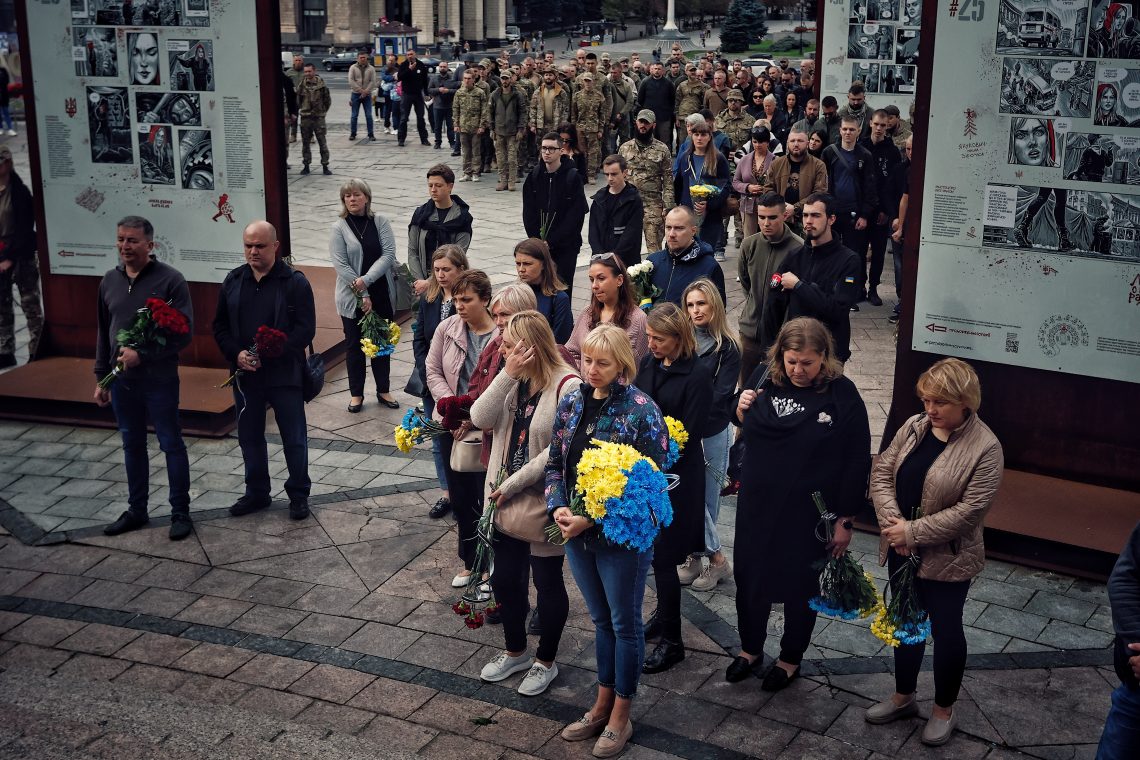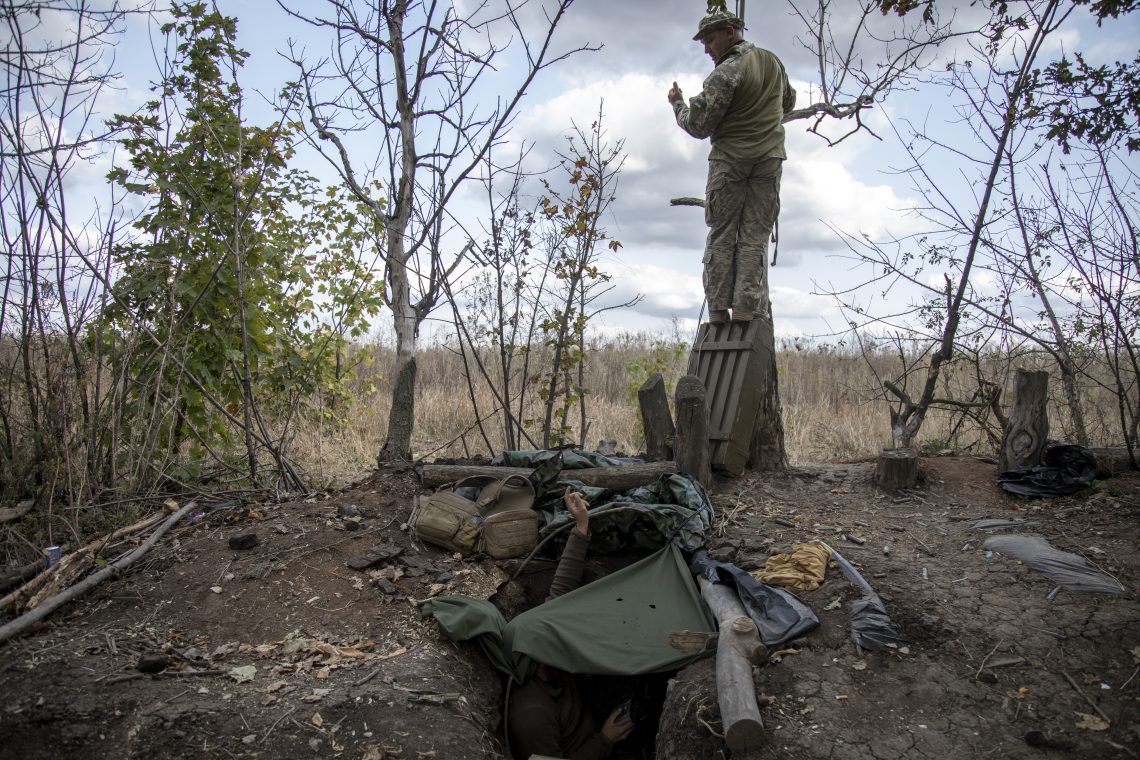Eyewitness to war: Assessing Ukraine’s counteroffensive
How one attack revealed the strengths, weaknesses and massive losses on both sides.

In a nutshell
- Russians have more manpower and artillery, but are a demoralized fighting force
- Faster armored advances are difficult, so trench warfare will likely dominate
- Winter fighting favors Ukraine because of better logistics, cold-weather equipment
The Ukrainian military’s incremental but steady gains along the front line rely on small-unit advances which are often scrappy, somewhat uncoordinated affairs. This operational strategy – while lacking finesse – gets the job done, albeit at perhaps higher-than-necessary costs in equipment and manpower. The bravery and creativity of Ukrainian forces cannot be overstated while Russian forces, at the trench level, are a demoralized and nearly inhuman fighting force. The advantages they hold in mass and artillery hold the balance for now, but it is difficult to see a sustainable trajectory for long-term occupation.
Also by Paul Schwennesen
Eyewitness to war: Assessing the Ukrainian capacity to fight
Operation ‘Kot’: One step forward, two steps back
“Kot” (Cat) was our target, an entrenched and fortified Russian machine-gun position at the front line near Bakhmut in eastern Donetsk Oblast. Occupying it was a brigade-level objective, to be coordinated within a larger push across multiple sectors toward the devastated and nearly empty city that once was home to some 72,000 people. The assault on Kot was tasked to the Chechen battalion, an untried asset within the brigade command.
The day before the attack, the Chechens asked for support from our American sniper-instructor team. With some reservations we agreed, pending a thorough review of the operational plan. On the one hand, we had been training with these fighters for weeks. On the other, we had little sense of the strategic plans, local hierarchy or tactical competencies at play.
By evening it was clear that the plan, while not sophisticated, was essentially sound. We were assured that resistance would be minimal, that the Russians numbered only 12 demoralized troops and that friendly artillery would effectively soften the target before the assault. In retrospect, these assurances ought to have given us pause.
It was a long night. The assault force, for reasons unclear to us, was infiltrated just after midnight. They endured indirect fire in shallow trenches for some 15 hours while the target was pounded by Ukrainian artillery and our sniper fire from 8 a.m. until the start of the assault at 3 p.m. The team was exhausted before the attack began in earnest.
When it did, confusion reigned, as it generally does amid the fog of war. Poor coordination with the adjacent sector left things unclear. We were ordered to begin our part of the operation only after the other sector had achieved something like “25 percent success,” whatever that meant. Muddled messages, muddled minds. Was the observed desultory fire the beginning of the promised artillery “barrage” or not? Radio security prevented clarification through direct communications.
By noon our snipers had rendered the machine gun inoperable, its sporadic bursts had fallen silent. Drones dominated the scene from both sides. By 3 p.m. the assault began as planned. It was then that the entire valley erupted in Russian artillery and the ostensibly “softened” position broke out in heavy small arms fire. There must have been dozens of occupiers, not the handful we believed were probably left. Where had they all come from?
The Chechens, per their reputation, fought like lions. I watched through my scope as they stormed the position, lobbing grenades and taking prisoners amid a hail of gunfire and artillery. In an age of tactical determinism and equipment focus, it was a reminder that raw human courage is still a factor that can turn the tide of battle. The panicking Russians, for their part, appeared to be shelling their own lines. The Chechens were outnumbered, outgunned and exhausted – attacking an entrenched position uphill in the dead heat of the day.
And yet they still won.
By dusk, after successfully storming the position and reinforcement by a Ukrainian regiment holding force, we began to get reports of our losses. A good many of our assault force members had been killed by enemy artillery before the attack gained momentum. One American, one Dane and many of our Chechen comrades were cut down in the confusion. Our snipers, battered by artillery, evacuated through a minefield at dusk. At a medical evacuation point, we assisted wounded fighters and helped clear the confusion among lost and wounded fighters trying to find their way to rendezvous and pickup points in the dark. Hours later, we were informed that “Kot” had been reoccupied by Russian forces who then proceeded to take an additional further position. One step forward, two steps back.

What does this setback show?
As an assessment of general Ukrainian command and control or tactical maneuvering, this operation is perhaps an unfair one to extrapolate too broadly from. Among other things, we Americans suffer from a nearly impenetrable language barrier. Nevertheless, some important tentative conclusions can be drawn that speak to Ukraine’s larger capacity for effective combined military operations.
Communications
While the equipment is present (encrypted two-way Motorola radios, Starlink, some satellite phones), training and practice – particularly in radio use – appear insufficient. Communication with brigade headquarters seemed to be more important than open dedicated channels among assault elements, with an emphasis on hierarchy over decentralized execution. By sheer luck, our sniper element played a vital radio relay role between headquarters and the field owing to line-of-sight coverage failures. Moreover, a major communications breakdown appears to have developed between operational sectors.
This was the second serious incident I have witnessed in which inter-sector coordination is absent, or at best confusing. Since our sector’s operation hinged on the activity of the neighboring sector, we expected better integration. On a positive note, battlefield commanders seemed to have had robust situational awareness, owing especially to the prevalence of effective drone surveillance. They were aware of the battle’s evolving aspects and were able to relay (albeit in somewhat confusing terms) the situation as it unfolded. However, the lack of clear protocols for terminology caused undue confusion both for our snipers and the assault force. Phrases like “behind you” and “right flank of the target” – instead of using cardinal directions – delayed response times and added undue stress to a highly charged situation.
Timing
The deplorably early infiltration of the assault team had serious consequences. The exhaustion of exposed troops very nearly stalled the assault before it began. Spending even an hour or two in some form of coordinated dress rehearsal would have been time much better spent. Radio etiquette, formation drills and coordination on maps would have integrated the joint operation immensely while still allowing for a nighttime deployment to avoid surveillance.
Concentrated firepower
We were assured that a major artillery barrage would begin promptly at 8 a.m. and that we were to obscure our sniper operations “within the smoke and confusion.” The barrage, such as it was, began late and was less than overwhelming – approximately one round every three to five minutes, sometimes as much as 10 minutes elapsing without fire. While it was reasonably well-aimed when it came, it failed to suppress the target, which kept up sporadic machine-gun fire throughout until snipers were able to neutralize the gunners. I have heard this elsewhere across the theater – that Ukrainian artillery seems averse to concentrated artillery fire. This operational norm may be due to fears of counter-battery fire or a desire to limit the use of ammunition, but the practical outcome of the approach negates some of the primary advantages of artillery. In any event, when Russian artillery responded, it was on the order of four to five times heavier and far more effective.
Overly cautious security and poor planning
There is an unfortunate phenomenon related to security and self-censorship. Ukrainians are highly concerned about Russian countersurveillance such as thermal drones, laser tracking and radio interception. They are wise to be cautious, of course, since such measures surely exist. However, to suppress Russian intercepts, Ukrainian forces often forego advantages in coordination that outweigh the potential risks of interception. Especially in isolated sectors, a more prudent risk assessment would accrue to Ukrainian advantage. Along these lines, I witnessed generally poor attention to operations and logistics planning. Operations like this one, though planned days in advance, did not prioritize clear, well-communicated plans across the multiple elements involved (artillery, assault, sniper and holding forces, etc.). Instead, a general mood of “just charge them” seems to prevail, to the detriment of forward momentum.
Observations of Russians: ‘They smelled like corpses’
Surveillance of the target in the hours before engagement revealed some striking, if not altogether surprising, observations. The first was that Russian troops were extraordinarily nonchalant. In comparison to Ukrainian positions, which are extremely cautious about drone surveillance, radio silence and more, the Russian position was almost comically inattentive. Their troops wandered about in broad daylight, away from cover, chatting on radios (we intercepted traffic talking about their families at home) and even balancing playfully on the sandbags around their machine gun position. The first casualty of the fight, taken by one of our snipers, was casually throwing dirt clods or bricks into a pile, apparently out of sheer boredom. As the morning wore on and as we watched their behavior, we began to wonder if they were drunk – a persistent rumor that seems substantiated by observation. Once sniper operations began, they were extraordinarily slow to react, allowing three or four more troops to be picked off before they began to slowly take cover.
To their credit, the fortifications the Russians had constructed were far more sophisticated than we had been led to believe. Once the position was taken, we learned that it extended some four meters underground in a complex system of trenches and tunnels.
Considering the artillery softening, sniper degradation and excessive heat, the fight they put up during the assault was considerably more than we anticipated. Only two offered to surrender. The rest fought for hours in a vicious, if desperate, standing firefight. Russian morale may be generally low, but not so low that they are eager to capitulate.
A word on the prisoners: I have never witnessed humans so reminiscent of the walking dead. Their skin was as sallow as candle wax, either from living underground or from fear of being captured by Chechens, or probably both. But it was their smell that astonished us all the most – they smelled like corpses and it was intolerable to be near them. This is likely from living in trenches littered with human remains. Our own positions had numerous human remains, the result of earlier fighting, but we occupied them for hours, not months on end. The situation, in short, is almost inconceivably bad for Russian occupiers, a good sign for Ukrainian counteroffensive forces.
Scenarios
Highly unlikely: A major Russian advance
It is highly unlikely that Russian forces will muster the logistical or moral capacity for any sustained advances beyond limited breakouts or holding operations at the current front line.
Somewhat likely: A Russian collapse
It is somewhat likely that Russian forward lines could experience a precipitous collapse. The lack of professionalism and the shockingly inhuman conditions of the forward defenders make this a distinct possibility. Mutinous rumblings have been reported in other sectors, and it is not inconceivable that mass panic may spread in the face of persistent Ukrainian advances.
Likeliest: Russia holds Ukraine to incremental gains
It is more likely that the sheer scale and mass of the Russian occupation, coupled with their effective artillery, ensures Ukrainian gains will be incremental for the rest of the fighting season. Since armored advances have been rendered somewhat irrelevant in the face of anti-armor weapons, trench-to-trench advances will probably continue at least to the coming spring. This means that the winter season will see a continuation of incremental advances. Considering Ukrainian advantages in internal logistics lines and superior cold-weather equipment, however, the winter may be an opportune moment for maximal pressure against a demoralized and dissolving occupying force.
For industry-specific scenarios and bespoke geopolitical intelligence, contact us and we will provide you with more information about our advisory services.









